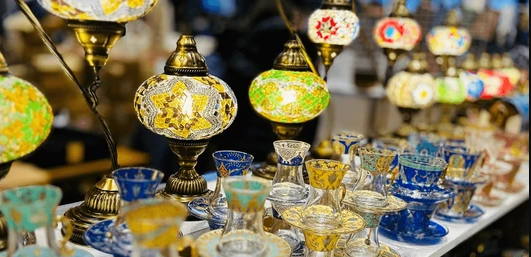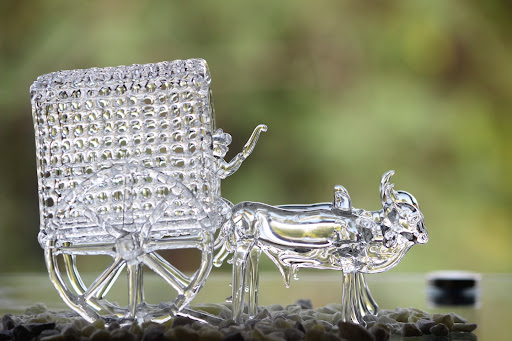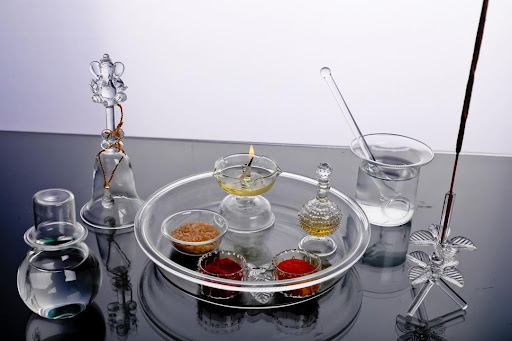Explore the Beauty of Crystal/Glass Handicraft

Throughout history, glass has proven to be a versatile medium for expressing creativity in a way that transcends cultural and temporal barriers. It offers a glimpse into the future while also reflecting the contemplative spirit of a post-contemporary society.
Glass-making is a craft that has limitless applications, from simple home decor glass items to intricate household items such as glass bangles, paintings, and mosaics. Its ever-evolving nature ensures that there is always something new to discover and appreciate within the realm of glass artistry.
 History of Crystal/Glass Craft Making
History of Crystal/Glass Craft Making
Humans have been trying their hands glass making and glass crafts since 4000 BCE. During this prehistoric period, humans had not yet discovered such an advanced glass-making technique, but their surrounding nature was always at their help, and they used natural glass, which is known as obsidian, a substance obtained from volcanic eruptions.
As time flew by, human minds figured out the glass recipe, a perfect blend of sand, lime and plant ash. And by time during 300 BCE, Syrian people invented a tool called a blowpipe, which became the main tool used for modern glass-making techniques.
As more decades and centuries passed by, European countries like Italy and Venice became the main hub for glass crafts-making industries. The glass-making technique was later moved to Asian countries by the British East India Company. China is said to be the first country where glass-making art was practiced first after the collaboration with the British East India Company.
Later with time, China brought the glass-making technique to India. During the initiation period, the dwellers of India would paint pictures related to ancient scriptures, popular stories, epic themes, icons, portraits, and icons. The art that unfurled within the colonial space of anglicized patronage bears testimony to grand architectural exploits in multicultural 21st-century India.
After the glass-making technique came to India, it started to be practiced at a huge level in the regions of Maharastra. And it was the medieval time when the crystal craft got a great jumpstart in its career.
Though the Chinese were responsible for the introduction of glass-making in India, it was the Mughals who supported this technique and excelled their artists in the art of making delicate glass objects. The Rajputs highly valued the craft because they appreciated beauty and artistry.
Magnificent Glass Craft Pieces
Creating a glass craft piece requires a lot of expertise, which is why the artist considers it a magnificent masterpiece. Rudhigat is a renowned supplier of breathtaking glass products, boasting an impressive array of exquisite diyas, Lord Krishna and Ganesha statues and unique gifts. Their master artisans can craft virtually anything from blown glass, including stunning home décor items, striking wall structures, and dazzling accessories, among others.
Each and every piece is meticulously designed with unparalleled attention to detail, surpassing the usual standards of glassware craftsmanship. The result is a stunning work of art that captures the eye and evokes a deep emotional response, leaving an indelible impression on all who behold it.
How to Take Care of Glass Craft Pieces?
When it comes to glass craft pieces, it's important to handle them with care to avoid any damage or breakage. These pieces can be a great addition to your home decor, adding a pop of color and beauty to any room. However, they can accumulate dirt over time and lose their shine, making them look dull and unappealing. Following simple cleaning tips is important to keep your glass crafts looking their best. By doing so, you can maintain their shine and beauty for years to come.
Tips for Dry Cleaning
- As we said, glass crafts are very brittle and can break easily, so whenever you plan to clean these delicate darlings, always use both your hands to hold and clean them.
- Always make sure that you touch these darlings with clean hands, as your dirty hands are enough to make them look dirty.
- Avoid wearing gloves while cleaning any glass artifact, as glasses have a slippery surface, and wearing gloves can make it hard for you to hold them tight.
- Never pick any of your glass artifacts from their mouth area. Always pick them up from the surface area, as the base is thicker than the tip area.
- Cotton clothes are preferred the most when it comes to cleaning, as they dry quickly and easily clean any surface. But little do you know that cotton clothes leave small fiber particles on the surface, making them look even dirtier if not cleaned appropriately. Always use a microfiber cloth for all kinds of cleaning.
Tips for Normal Cleaning
- For normal cleaning, too, always use a microfiber cloth instead of anything like cotton cloth, and wipe the artifact piece with the damp cloth and wipe the artifact gently.
- If your glass items are thicker than usual, it is nice to be somewhat liberal with them, but they are still glass items. They need to be handled with care. Cleaning them with a low-pH level soap and gently wiping them with lukewarm soapy water will maintain shine.
- Avoid harsh chemical cleaning solutions, as they can impact your artifacts for a long time, leaving a cloudy effect patch.
- There are solutions available in the market that can be used to clean your glasses. Make some use of those clear and protect your glass crafts.
Tips for Drying
What's the big deal in drying these beautiful pieces? They will dry on their own. But let me stop you right here because that is not true. Drying tips are as important as cleaning tips. Cleaning with water and leaving it as it is for drying will leave water marks (wiping marks) on its surface, which will deteriorate its look. Follow these drying tips, and you are good to go.
- Avoid washing two or more artifacts together, as they can scratch each other and damage their respective surfaces.
- Avoid putting too hot or too cold liquid in the glass. It may crack over time.
- Never use aerosol cleaners for cleaning glass artifacts.
Ending Note
Glass artifacts will surely enhance your home interior, but you are responsible for caring for those delicate darlings. Artists have spent several hours crafting the perfect glass artifact for you. Follow the above-mentioned steps and handle the artifacts carefully.
If you are looking for glass artifacts at very reasonable prices, then Rudhigat is your one-stop shop. Browse through our web store and fall in love with Indian handicraft items whenever you come across a new item from our store.















